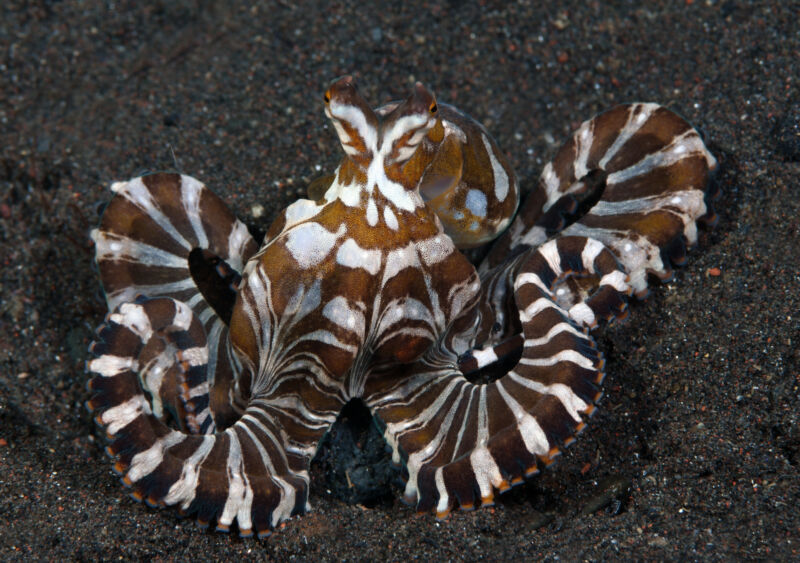
Octopuses and other camouflaging cephalopods may be the literal embodiment of “now you see me, now you don’t.” Using both rapid colour and texture changes, octopuses can blend into nearly every environment by mimicking things like fish on the sea floor or plants swaying with the waves. A cephalopod’s seamless camouflage makes it tricky for researchers to identify, track, and monitor these creatures in the wild, which has limited our ability to study them.
This may change for some species, thanks to new research from the University of California, Berkeley, published in PLOS ONE. The UC Berkeley researchers studying the lesser Pacific striped octopus (also called the zebra octopus, Octopus chierchiae), found that the animals’ striping patterns seemed to be individualized, similar to our fingerprint patterns. As this small cephalopod has previously been recommended as a new model organism for future studies, having these octopus “fingerprints” could help to solidify O. chierchiae’s place as the poster child for cephalopod research.
Cultivating laboratory octopuses
Studying octopuses in a laboratory is not for the faint-hearted. Most species usually live for one to three years and produce only one clutch of eggs during that time, making it difficult to track any sort of genetic lineage. Their intelligence and impish behavior make it tricky to keep them in an artificial habitat. Octopuses are predatory creatures, so they require the mental stimulation of hunting, along with special diets to maintain their well-being. Previous studies have shown that caged octopuses will cannibalize each other without proper nourishment.
O. chierchiae has proved an exception. Its small body makes it easier to maintain, and unlike most of its relatives, it will produce a clutch of eggs every 30 to 90 days, making it easier to track genetic traits. These octopuses can live up to eight years, as well. And now, researchers may also be able to identify specific individuals within their studies.
Only one other cephalopod species has previously been identified by its stripes: Wunderpus photogenicus, also known as the wunderpus. Like O. chierchiae, the wunderpus is a small octopus with individualized black-and-white stripes. The researchers at UC Berkeley were curious to see if this individualization translated to O. chierchiae.
“Originally, we were just trying to figure out how to breed them in captivity, but we noticed that all of the individuals looked different, and we could easily identify them by their stripe patterns, even if they escaped from their labeled jars into the larger tank,” explained researchers Benjamin Liu, Leo Song, Saumitra Kelkar, and Anna Ramji. “Dr. Roy Caldwell, our mentor and the PI [principal investigator] of the lab, recommended that we investigate whether this could be useful to the study of this species.”
As the team explained: “Dr. Christine Huffard, one of Caldwell’s former graduate students, led a study on the unique body patterns of Wunderpus photogenicus, an Indo-Pacific octopus species. In that paper, the authors showed that the body patterns of adult octopuses remain constant in aquaria and captured photos that appear to show the same individual octopus in the wild many months apart.”
While raising a new clutch of O. chierchiaes, the team found similarities to what Huffard had seen. “We noticed that the baby octopuses we were raising seemed to retain the same stripe patterns from the age that the stripes are first visible—the stripe pattern never shifted, it just grew proportionally to the animal, in every baby octopus we raised and observed,” they added. “We thought this was interesting and worth reporting, and possibly useful for the potential study of this species’ life history and ecology in the wild.”
The UC Berkeley researchers looked at 25 of the 156 octopuses that they had in the laboratory and were able to photograph their striping patterns. While the patterns didn’t appear until day five of the hatchling’s existence, these stripes would stay with them throughout their life. “The dominant stripes are landmarks on the skin,” explained Dr. Z Yan Wang, an assistant professor of biology at the University of Washington. “They are dynamic in the sense that they can get darker or lighter. But as far as we know, the particular stripes themselves are permanent.”
To verify their hypothesis, the UC Berkeley researchers raising the hatchlings asked 38 volunteers to look at photos of two O. chierchiae octopuses and try to determine if the animals were different. What they found confirmed that the octopuses did have their own type of “fingerprint” signatures, as the volunteers found distinct differences 84 percent of the time, with over half of the volunteers seeing differences 90 percent of the time or higher.


3175x175(CURRENT).thumb.jpg.b05acc060982b36f5891ba728e6d953c.jpg)

Recommended Comments
There are no comments to display.
Join the conversation
You can post now and register later. If you have an account, sign in now to post with your account.
Note: Your post will require moderator approval before it will be visible.